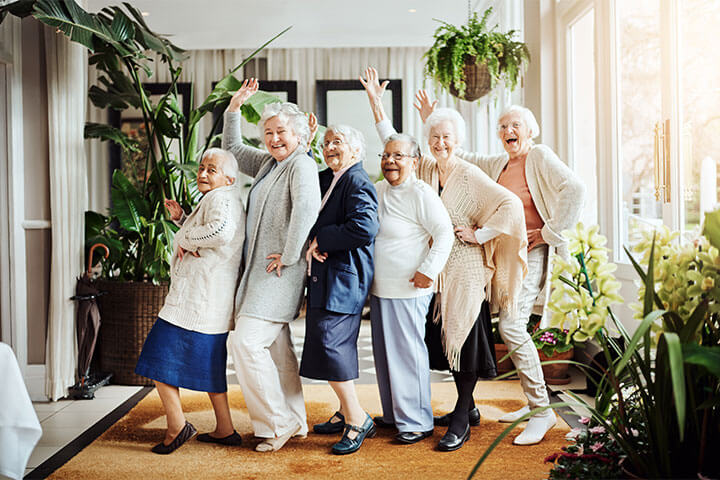The senior living industry is a competitive one, with many facilities vying for the attention of potential residents. To stand out from the crowd, senior living facilities are increasingly differentiating themselves with innovative care programs to meet the needs of their residents.
In this article, we look at the specific ways modern operators are attracting and retaining residents. These strategies may involve using new technologies, implementing new practices, or simply changing the way that care is delivered.
Why Has the Senior Living Industry Grown More Competitive?

The senior living industry in the United States is getting more competitive in part because the needs of seniors are changing. Many seniors are now living longer and healthier lives, and they are looking for senior living options that offer a variety of activities and amenities.
However, the customer base for senior living is also fragmented, meaning that there is no single group of customers who are all looking for the same type of senior living. This fragmentation makes it difficult for providers to target their marketing and sales efforts.
Another factor contributing to senior living competition is the cost of entry into the senior living industry is relatively low which has led to an influx of new providers. For example, private equity firms have been investing heavily in the senior living industry in recent years. This investment has led to the construction of new senior living facilities and the acquisition of existing facilities.
To succeed in this competitive marketplace, many senior living providers are offering a variety of services and amenities to meet the needs of their residents.
Innovative Care Practices Are Changing the Way We Age
By differentiating themselves, senior living facilities are able to attract and retain residents who are looking for a high-quality and enriching place to live. Pricing aside, amenities, activities, culture, pets, and technology are often the determining factors that lead a resident to choose one campus over another.
A Choice of Amenities

Senior living establishments that offer a wide range of amenities are more likely to attract residents. For example, a state-of-the-art fitness center or pool attracts residents who want to stay fit. Some centers offer both heated indoor and outdoor pools. State-of-the-art fitness centers and pools are often sought after amenities because they provide residents with a variety of ways to stay active, healthy, and entertained.
A senior living establishment with on-site dining may be a good choice for residents who have difficulty cooking for themselves or simply for those that like to entertain. Some senior living communities offer a variety of on-campus restaurants where they can bring guests or simply enjoy good food with their fellow residents.
After cooking for their families for so many years, some seniors find it liberating to allow someone else to handle the meal prep. On-site dining ranges in offerings, with some facilities providing both bistros and fine-dining options. The menu options can be discussed with residents prior to menu creation, to gain valuable insight on their preferences and let them know their opinion matters.
Activities Seniors Enjoy

Many operators offer continuing education programs for their residents, helping them stay active and engaged lifelong learners. Some facilities offer a variety of continuing education classes in subjects such as art, computers, and foreign language. These classes provide residents with opportunities to learn new skills, meet new people, and stay mentally sharp.
Another way seniors stay active and engaged is many senior living establishments offer volunteer opportunities. Residents can spend their time giving back to their communities and fulfilling the need to find a sense of purpose.
Some volunteer programs focus on intergenerational activities. These programs bring together residents of senior living facilities with children from local schools or daycares. Seniors can spend their time tutoring kids, assisting children with gardening, serving meals, or helping special-needs children improve their social skills.
Fostering a Warm Culture

Senior living establishments that create a warm and welcoming atmosphere are more likely to appeal to residents and their families. Many senior living facilities are now focused on creating a sense of community and belonging for their residents by providing opportunities to socialize and connect with one another, by offering a variety of activities and programs, and by creating a welcoming and homelike environment.
As we’ve mentioned, activities keep residents engaged with their mind. Additionally, shared activities help residents meet new people, and are an excellent choice for those who want to feel surrounded by friends and neighbors. Participating in wine tastings, cooking classes, painting nights, gardening clubs, game nights, dancing, and other social events help build comradery and a sense of community.
Culture can greatly vary between centers. Some residents are looking for a more casual and informal atmosphere focused on wellness activities such as green living programs, music therapy programs, digital detoxing, and dedicated spaces for creating art and woodworking.
Overall, these programs demonstrate that there is no one-size-fits-all approach to senior living. The most successful programs tailor to the needs of individual residents.
Animals Welcome

One study found that pet therapy can reduce stress levels in older adults by up to 30%. Having to leave a pet behind can be emotionally devastating for many seniors which is why more and more establishments are becoming pet friendly. Residents are welcome to bring their dogs, cats, and other small pets with them, providing companionship and a feeling of home.
Studies have also shown that interacting with animals have a positive impact on mental and physical health, so some senior living facilities have started offering pet therapy programs. Residents can interact with animals, such as dogs and cats, on a regular basis. This can help to reduce stress, improve mood, and boost overall well-being.
Accessible Technology

Senior living establishments are increasingly using technology to improve the lives of their residents. Some facilities use tablets and other devices to help manage their care and help them stay connected to family and friends.
Technology helps keep residents entertained, educated, and socially connected. For instance, one senior living community has a virtual reality program that allows residents to experience different places and activities without leaving the comfort of their home. This program is especially beneficial for residents with mobility issues.
More Than Just a Place to Live

The senior living industry is constantly evolving, and new ways to differentiate are emerging all the time. By staying up to date on the latest trends and offering a variety of unique and differentiated services, senior living establishments can ensure that they are well-positioned to compete in the marketplace, meet the needs of their residents, and improve the quality of life for everyone.



